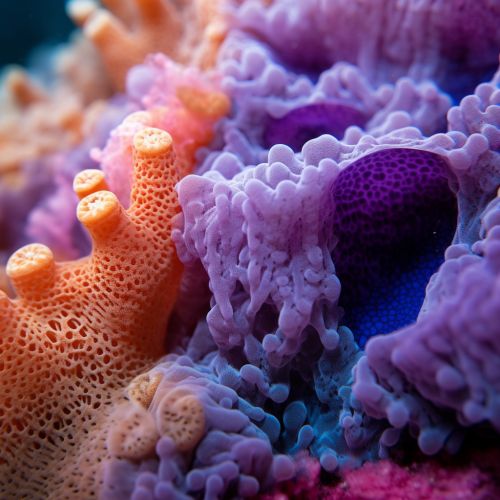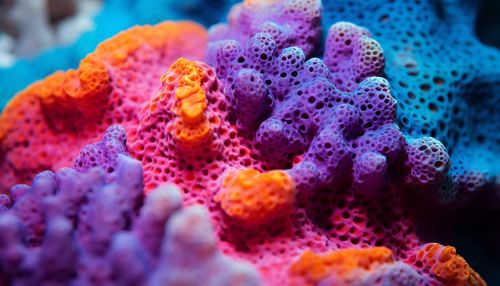Marine sponges
Introduction
Marine sponges, also known as Porifera, are a group of simple multicellular organisms that are primarily marine in nature. They are one of the most ancient forms of life on Earth, with fossil records dating back to the Precambrian era. Marine sponges are characterized by their porous bodies and lack of true tissues and organs, a trait that sets them apart from other multicellular organisms. They are filter feeders, drawing water in through their pores to extract nutrients and oxygen filter feeding.


Classification
Marine sponges belong to the phylum Porifera, which is divided into three main classes: Calcarea, Hexactinellida, and Demospongiae. Each class is distinguished by the type of spicules - small, spike-like structures - present in their bodies spicules.
Calcarea
Sponges in the class Calcarea are characterized by their calcium carbonate spicules. They are usually small, rarely exceeding 15 cm in length, and are found in both shallow and deep waters. Calcarea sponges can be either asconoid, syconoid, or leuconoid in structure asconoid, syconoid, leuconoid.
Hexactinellida
Hexactinellida, or glass sponges, have siliceous spicules with six rays. They are predominantly deep-sea dwellers and have a unique tissue structure that allows them to conduct electrical signals, a feature not found in other sponge classes glass sponges.
Demospongiae
Demospongiae is the largest class of sponges, comprising about 90% of all known sponge species. These sponges have siliceous spicules, spongin fibers, or both. They display a wide range of colors, shapes, and sizes, and are found in various marine environments, from freshwater to the deepest oceans demosponges.
Anatomy and Physiology
Despite their simple structure, marine sponges have a complex system of water canals and chambers that facilitate their filter-feeding lifestyle. The body wall is perforated with pores, or ostia, through which water enters the sponge. This water is then directed into a system of canals and eventually expelled through a large opening called the osculum osculum.
Sponges lack true tissues and organs but have specialized cells for different functions. Choanocytes, or collar cells, line the interior of the sponge and create a water current through their flagella. They also capture and digest food particles. Other cell types include pinacocytes, porocytes, archaeocytes, and sclerocytes, each with their own specific roles choanocytes, pinacocytes, porocytes, archaeocytes, sclerocytes.
Reproduction and Life Cycle
Marine sponges can reproduce both sexually and asexually. Asexual reproduction occurs through budding, fragmentation, or the formation of gemmules - resistant structures that can survive harsh environmental conditions budding, fragmentation, gemmules.
Sexual reproduction in sponges is unique. Most sponge species are hermaphroditic, possessing both male and female reproductive cells. However, they do not self-fertilize. Instead, they release sperm into the water, which is captured by other sponges and used to fertilize their eggs internally. The fertilized eggs develop into larvae, which are then released into the water. These larvae float in the water column until they find a suitable substrate to attach to and grow hermaphrodites.
Ecological Role
Marine sponges play a vital role in marine ecosystems. As filter feeders, they help maintain water quality by removing bacteria and other microscopic particles from the water column. They also serve as habitat for a variety of organisms, including many species of fish and invertebrates. Furthermore, sponges are important in nutrient cycling, particularly in coral reef ecosystems coral reefs.
Human Uses
Humans have utilized marine sponges for thousands of years. Historically, they were harvested and used as bath sponges. Today, they are also used in scientific research, particularly in the field of medicine. Many sponges produce bioactive compounds with potential pharmaceutical applications, including anticancer, antiviral, and antibacterial agents bioactive compounds.
Conservation
While marine sponges are not typically the focus of conservation efforts, they face threats from climate change, ocean acidification, and destructive fishing practices. Some species are also harvested for commercial use, which can lead to population declines if not managed sustainably climate change, ocean acidification.
